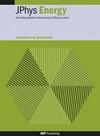Modulation of electrocatalytic activity by tuning anion electronegativity: case study with copper chalcogenides
IF 6.3
3区 材料科学
Q1 ENERGY & FUELS
引用次数: 0
Abstract
Abstract Anion-tuning in metallic chalcogenides has been shown to have a significant impact on their electrocatalytic ability for overall water splitting. In this article, copper-based chalcogenides (Cu 2 X, X = O, S, Se, and Te) have been systematically studied to examine the effect of decreasing anion electronegativity and increasing covalency on the electrocatalytic performance. Among the copper chalcogenides, Cu 2 Te has the highest oxygen evolution reaction (OER) activity and can sustain high current density of 10 and 50 mA cm −2 for 12 h. The difference in intrinsic catalytic activity of these chalcogenide surfaces have been also probed through density functional theory calculations, which was used to estimate energy of the catalyst activation step. It was observed that the hydroxyl adsorption on the surface catalytic site is critically important for the onset and progress of OER activity. Consequently, it was also observed that the –OH adsorption energy can be used as a simple but accurate descriptor to explain the catalytic efficiency through volcano-like correlation plot. Such observation will have a significant impact on developing design principle for optimal catalytic surface exhibiting high performance as well as prolonged stability.调节阴离子电负性对电催化活性的影响:以铜硫属化合物为例
金属硫族化合物中的阴离子调谐对其整体水裂解的电催化能力有显著影响。本文系统地研究了铜基硫族化合物(cu2x、X = O、S、Se和Te),考察了阴离子电负性降低和共价增加对电催化性能的影响。在硫族铜中,cu2te具有最高的析氧反应(OER)活性,可以维持10和50 mA cm−2的高电流密度12 h。通过密度泛函理论计算,探讨了这些硫族铜表面的本构催化活性的差异,并使用密度泛函理论计算来估计催化剂激活步骤的能量。观察到羟基在表面催化位点的吸附对OER活性的发生和发展至关重要。结果表明,-OH吸附能可以作为一个简单而准确的描述符,通过类似火山的相关图来解释催化效率。这一观察结果将对开发具有高性能和长时间稳定性的最佳催化表面的设计原则产生重大影响。
本文章由计算机程序翻译,如有差异,请以英文原文为准。
求助全文
约1分钟内获得全文
求助全文
来源期刊

Journal of Physics-Energy
Multiple-
CiteScore
10.90
自引率
1.40%
发文量
58
期刊介绍:
The Journal of Physics-Energy is an interdisciplinary and fully open-access publication dedicated to setting the agenda for the identification and dissemination of the most exciting and significant advancements in all realms of energy-related research. Committed to the principles of open science, JPhys Energy is designed to maximize the exchange of knowledge between both established and emerging communities, thereby fostering a collaborative and inclusive environment for the advancement of energy research.
 求助内容:
求助内容: 应助结果提醒方式:
应助结果提醒方式:


